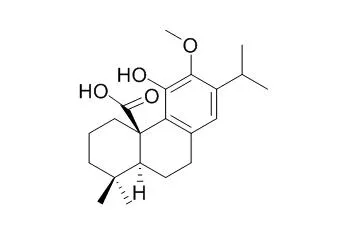| In vitro: |
| J Agric Food Chem. 2003 Jul 16;51(15):4247-53. | | Phenolic diterpenes, flavones, and rosmarinic acid distribution during the development of leaves, flowers, stems, and roots of Rosmarinus officinalis. Antioxidant activity.[Pubmed: 12848492 ] |
METHODS AND RESULTS:
The distribution of six compounds with three different polyphenol skeletons have been studied in Rosmarinus officinalis: phenolic diterpenes (carnosic acid, carnosol, and 12-O-Methylcarnosic acid), caffeoyl derivatives (rosmarinic acid), and flavones (isoscutellarein 7-O-glucoside and genkwanin), each showing a characteristic behavior and distribution during the vegetative cycle. Only in leaves were all six compounds present, and the highest accumulation rate was related with the young stages of development. Rosmarinic acid showed the highest concentrations of all the polyphenols in all organs. The distribution of this acid in leaves, flowers, and stems suggests that in the first stages of flower growth, levels were due to in situ biosynthesis, and in the last stages, the contribution of transport phenomena was increased.
The antioxidant activity of six extracts with different polyphenolic composition was evaluated in aqueous and lipid systems.
CONCLUSIONS:
The results clearly suggest that rosemary extracts are excellent antioxidants in both aqueous and lipid systems. | | Planta Med 2015; 81 - SL3B_04 | | Ursolic acid and 12-O-methylcarnosic acid from the leaves of Rosmarinus officinalis L. suppressed melanin production with downregulation of tyrosinase expression in HMV-II melanoma cells[Reference: WebLink] | | A total of 15 samples of extracts obtained from horticultural herbal therapy plants were examined. Based on IC50 values, the highest inhibitory effect on melanogenesis was observed with extracts from the leaves of Rosmarinus officinalis L. (rosemary). This extract showed stronger activity than the flowers of Erica vulgaris (heath), which include abundant levels of the major skin whitening compound, arbutin (positive control). Next, we isolated active compounds from rosemary by melanogenesis inhibitory activity-guided fractionation, identifying ursolic acid (1) and 12-O-Methylcarnosic acid (2) as the main bioactive compounds. Compared with 1 and its isomers (betulinic acid (3) and oleanic acid (4)) at the concentration of 7.5 μM, inhibitory effects of 1 and 3 were 67.2 ± 9.4% and 0.5 ± 0.5% (% to control), respectively. Compound 3 showed high cytotoxicity (viability, 7.4 ± 1.4%), while 4 had no effect inhibiting melanogenesis. Tyrosinase is one of the key enzymes involved in melanogenesis. We therefore studied whether these compounds would suppress expression of tyrosinase on HMV-II cells. Compounds 1, 2, and 3 showed downregulation of tyrosinase expression, according to the results of western blotting. |
|
| In vivo: |
| Planta Med. 2011 Jun;77(9):882-7. | | Gastroprotective effect and cytotoxicity of carnosic acid derivatives.[Pubmed: 21246485 ] | Carnosic acid (CA) is the main phenolic diterpene of rosemary (Rosmarinus officinalis L., Lamiaceae) and presents gastroprotective effect in vitro and in vivo.
METHODS AND RESULTS:
To determine structure-activity relationships, seventeen esters and ethers of CA were prepared, comprising aliphatic, aromatic, and heterocyclic compounds. The naturally occurring 12-O-Methylcarnosic acid (14) was also included in the study. The compounds were evaluated for their gastroprotective activity in the HCl/EtOH-induced gastric lesions model in mice, and for cytotoxicity in human adenocarcinoma AGS cells, Hep G2 hepatocellular carcinoma cells, and human lung fibroblasts. At 10 mg/kg, some of the CA derivatives (5, 8, 9, 12, 14, and 18) were more effective preventing gastric lesions than the reference compound lansoprazole at the same dose.
CONCLUSIONS:
The dibenzoate 9, diindoleacetate 12, and the derivative 18 showed the best gastroprotective effect combined with the lowest cytotoxicity. |
|






 Cell. 2018 Jan 11;172(1-2):249-261.e12. doi: 10.1016/j.cell.2017.12.019.IF=36.216(2019)
Cell. 2018 Jan 11;172(1-2):249-261.e12. doi: 10.1016/j.cell.2017.12.019.IF=36.216(2019) Cell Metab. 2020 Mar 3;31(3):534-548.e5. doi: 10.1016/j.cmet.2020.01.002.IF=22.415(2019)
Cell Metab. 2020 Mar 3;31(3):534-548.e5. doi: 10.1016/j.cmet.2020.01.002.IF=22.415(2019) Mol Cell. 2017 Nov 16;68(4):673-685.e6. doi: 10.1016/j.molcel.2017.10.022.IF=14.548(2019)
Mol Cell. 2017 Nov 16;68(4):673-685.e6. doi: 10.1016/j.molcel.2017.10.022.IF=14.548(2019)